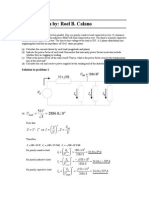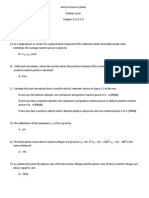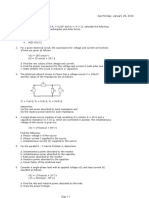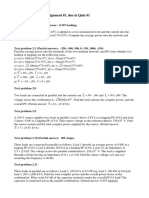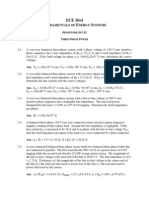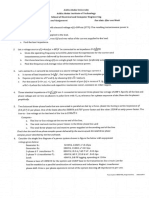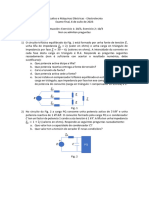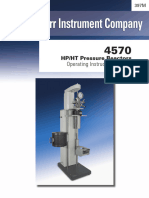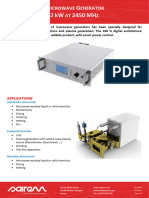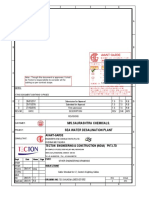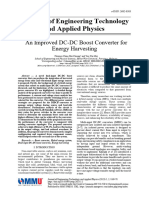2.
7 Let a 100-V sinusoidal source be connected to a series combination of a 3-Ω resistor, an 8-Ω
inductor, and a 4-Ω capacitor. (a) Compute the series impedance. (b) Determine the current I
delivered by the source. Is the current lagging or leading the source voltage? What is the power
factor of this circuit?
2.10 The voltage across a circuit element is v(t) = 400 sin (ωt + 30°) volts, and the current entering
the positive terminal of the circuit element is i(t) = 100 cos(ωt + 10°) A. Calculate (a) the real power
(state whether it is delivered or absorbed), (b) the reactive power (state whether delivered or
absorbed), (c) the power factor (state whether lagging or leading).
2.11 A 60-Hz, single-phase source with V = 277∠30° volts is applied to a circuit element. Determine
the real power, and reactive power absorbed by (a) the 20-Ω resistor, (b) the 10-mH inductor, and (c)
the capacitor with 25-Ω reactance. Also, determine the source power factor and state whether it is
lagging or leading.
2.12 The voltage v(t) = 359.3 cos(ωt) volts is applied to a load consisting of a 10-resistor in parallel
with a capacitive reactance Xc = 25 Ω. Calculate (a) the real power absorbed by the resistor, (b) the
reactive power delivered by the capacitor, and (c) the load power factor.
2.14 A single-phase source is applied to a two-terminal, passive circuit with equivalent impedance Z =
3.0 ∠-45° Ω, measured from the terminals. The source current is i(t) = 2√ 2 cos(ωt) kA. Determine
the (a) real power, reactive power delivered by the source, and source power factor.
2.16 A single-phase, 120-V (rms), 60-Hz source supplies power to a series R-L circuit consisting of R =
10 Ω and L = 40 mH. (a) Determine the power factor of the circuit and state whether it is lagging or
leading. (b) Determine the real and reactive power absorbed by the load.
2.19 Consider a single-phase load with an applied voltage v(t)=150 cos(ωt + 10°) volts and load
current i(t) = 5 cos(ωt - 50°) A. (a) Determine the power triangle. (b) Find the power factor and
specify whether it is lagging or leading. (c) Calculate the reactive power supplied by capacitors in
parallel with the load that correct the power factor to 0.9 lagging.
2.20 A circuit consists of two impedances, Z1 = 20∠30° Ω and Z2 = 25∠60° Ω, in parallel, supplied by
a source voltage V = 100∠60° volts. Determine the power triangle for each of the impedances and
for the source.
2.21 An industrial plant consisting primarily of induction motor loads absorbs 500 kW at 0.6 power
factor lagging. (a) Compute the required kVA rating of a shunt capacitor to improve the power factor
to 0.9 lagging. (b) Calculate the resulting power factor if a synchronous motor rated at 500 hp with
90% efficiency operating at rated load and at unity power factor is added to the plant instead of the
capacitor. Assume constant voltage (1 hp = 0.746 kW).
2.22 The real power delivered by a source to two impedances, Z1 = 4 + j5 Ω and Z2 = 10 Ω, connected
in parallel, is 1000 W. Determine (a) the real power absorbed by each of the impedances, and (b) the
source current.
2.23 A single-phase source has a terminal voltage V = 120∠0° volts and a current I = 12∠30° A,
which leaves the positive terminal of the source. Determine the real and reactive power, and state
whether the source is delivering or absorbing each.
�2.24 For a capacitor and resistor in parallel that, when operated at 120 V, consume 8 A of current at a
power factor of 0.86 leading, (a) what are the apparent, real, and reactive power consumed by the
combination, and (b) what are the values of the resistance in ohms and capacitance in farads?
(Assume the system is operated at 60 Hz.)
2.25 An inductor has an inductance of 15 mH. If the ac voltages on each side of the inductor both
have a magnitude of 100 V and frequency of 60 Hz, what is the maximum power that can be
transferred through the inductor?
2.26 A small manufacturing plant is located 2 km down a transmission line, which has a series
reactance of 0.5 Ω/km. The line resistance is negligible. The line voltage at the plant is 480∠30° V
(rms), and the plant consumes 120 kW at 0.85 power factor lagging. Determine the voltage and
power factor at the sending end of the transmission line by using: (a) a complex power approach
2.27 An industrial load consisting of a bank of induction motors consumes 50 kW at a power factor of
0.8 lagging from a 220-V, 60-Hz, single-phase source. By placing a bank of capacitors in parallel with
the load, the resultant power factor is to be raised to 0.95 lagging. Find the net capacitance of the
capacitor bank in mF that is required.
2.28 Three loads are connected in parallel across a single-phase source voltage of 240 V (RMS).
Load 1 absorbs 15 kW and 6.667 kvar;
Load 2 absorbs 3 kVA at 0.96 pf leading;
Load 3 absorbs 15 kW at unity power factor.
Calculate the equivalent impedance, Z, for the three parallel loads, for two cases: (a) Series
combination of R and X, and (b) parallel combination of R and X
2.40 A balanced three-phase 240-V source supplies a balanced three-phase load. If the line current
IA is measured to be 12 A and is in phase with the line-to-line voltage, VBC, find the per-phase load
impedance if the load is (a) Y-connected, (b) Δ-connected.
2.41 A three-phase 25-kVA, 480-V, 60-Hz alternator, operating under balanced steady-state
conditions, supplies a line current of 20 A per phase at a 0.8 lagging power factor and at rated
voltage. Determine the power triangle for this operating condition.
2.42 A balanced Δ-connected impedance load with (12 + j9) Ω per phase is supplied by a balanced
three-phase 60-Hz, 208-V source. (a) Calculate the line current, the total real and reactive power
absorbed by the load, the load power factor, and the apparent load power. (b) A phasor diagram
showing the line currents, the line-to-line source voltages, and the Δ-load currents. Use Vab as the
reference.
2.43 A three-phase line, which has an impedance of (2 + j4) Ω per phase, feeds two balanced three-
phase loads that are connected in parallel. One of the loads is Y-connected with an impedance of (30
+ j40) Ω per phase, and the other is Δ-connected with an impedance of (60 - j45) Ω per phase. The
line is energized at the sending end from a 60-Hz, three-phase, balanced voltage source of 120√ 3 V
(rms, line-to-line). Determine: (a) the current, real power, and reactive power delivered by the
sending-end source; (b) the line-to-line voltage at the load; (c) the current per phase in each load;
and (d) the total three-phase real and reactive powers absorbed by each load and by the line. Check
�that the total three-phase complex power delivered by the source equals the total three-phase
power absorbed by the line and loads.
2.44 A Y-connected three-phase resistive load has an a-phase current of 50∠0°A. What should the
angle of the line-to-line voltage Vbc be if the system is balanced?
2.45 There are four three-phase devices connected in parallel: (a) a delta-connected capacitor bank
with C = 163 microF, (b) a Y-connected bank of inductors with L = 10 mH, (c) a delta-connected
inductor bank with L = 3 mH, and (4) a delta-connected resistor bank. At what frequency will the
power factor of the entire combination be unity?
2.46 Three identical impedances ZΔ = 30∠0°Ω are connected in Δ to a balanced three-phase 208-V
source by three identical line conductors with impedance ZL = (0.8 + j0.6) Ω per line. (a) Calculate the
line-to-line voltage at the load terminals. (b) Repeat part (a) when a Δ-connected capacitor bank
with reactance (-j60) Ω per phase is connected in parallel with the load.
2.47 Two three-phase generators supply a three-phase load through separate three-phase lines. The
load absorbs 30 kW at 0.8 power factor lagging. The line impedance is (1.4 + j1.6) Ω per phase
between generator G1 and the load, and (0.8 + j1) Ω per phase between generator G2 and the load.
If generator G1 supplies 15 kW at 0.8 power factor lagging, with a terminal voltage of 460 V line-to-
line, determine: (a) the voltage at the load terminals, (b) the voltage at the terminals of generator
G2, and (c) the real and reactive power supplied by generator G2. Assume balanced operation.
2.48 Two balanced Y-connected loads in parallel, one drawing 15 kW at 0.6 power factor lagging and
the other drawing 10 kVA at 0.8 power factor leading, are supplied by a balanced, three-phase, 480-
volt source. (a) Draw the power triangle for each load and for the combined load. (b) Determine the
power factor of the combined load and state whether lagging or leading. (c) Determine the
magnitude of the line current from the source. (d) Δ-connected capacitors are now installed in
parallel with the combined load. What value of capacitive reactance is needed in each leg of the Δ to
make the source power factor unity? Give your answer in Ω. (e) Compute the magnitude of the
current in each capacitor and the line current from the source.
2.52 A balanced three-phase load is connected to a 4.16-kV, three-phase, four-wire, grounded-Y
dedicated distribution feeder. The load can be modeled by an impedance of ZL = (4.7 + j9) Ω/phase,
wye-connected. The impedance of the phase conductors is (0.3 + j1) Ω. Determine the following by
using the phase A to neutral voltage as a reference and assume positive phase sequence: (a) Line
currents for phases A, B, and C. (b) Line-to-neutral voltages for all three phases at the load. (c)
Apparent, active, and reactive power dissipated per phase, and for all three phases in the load. (d)
Active power losses per phase and for all three phases in the phase conductors.




